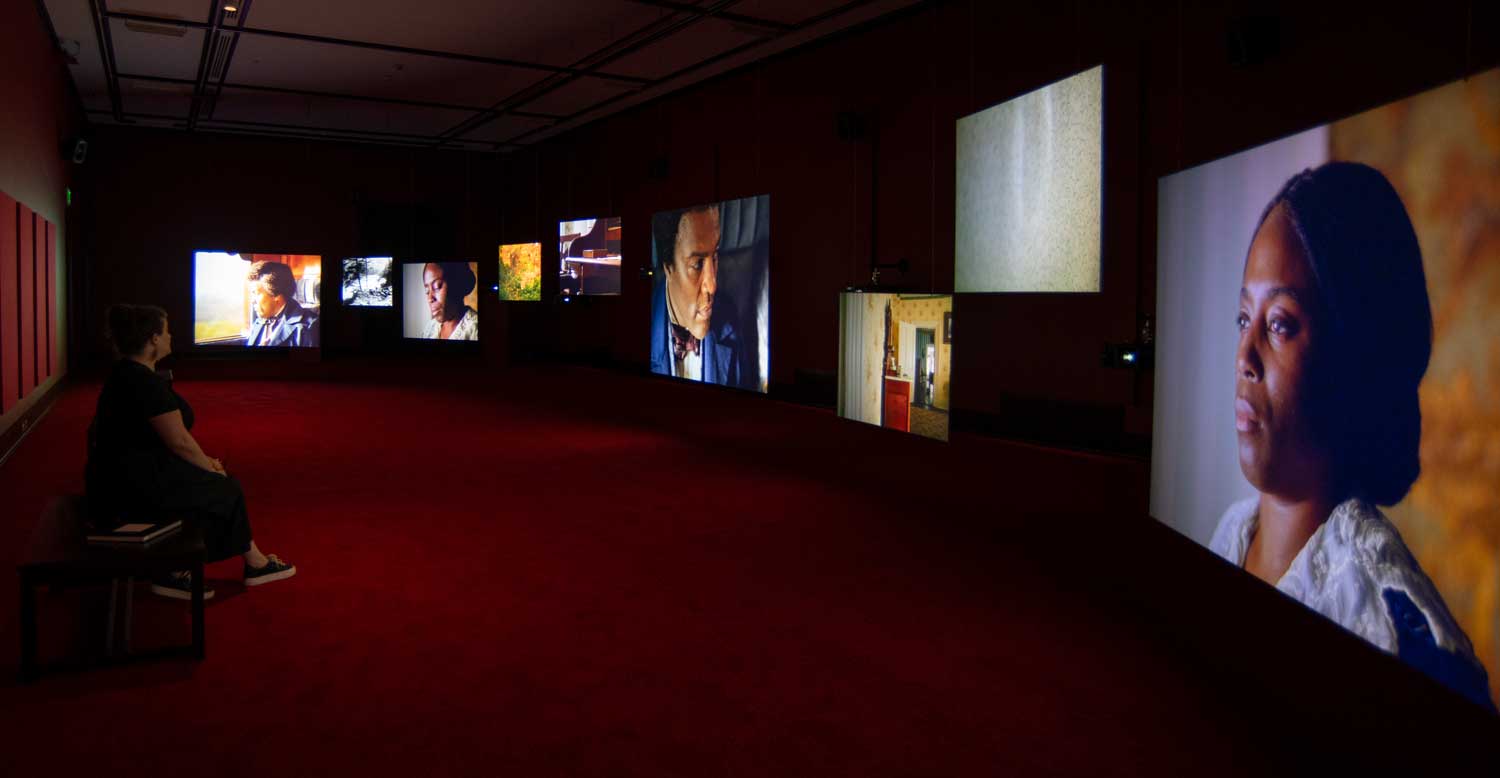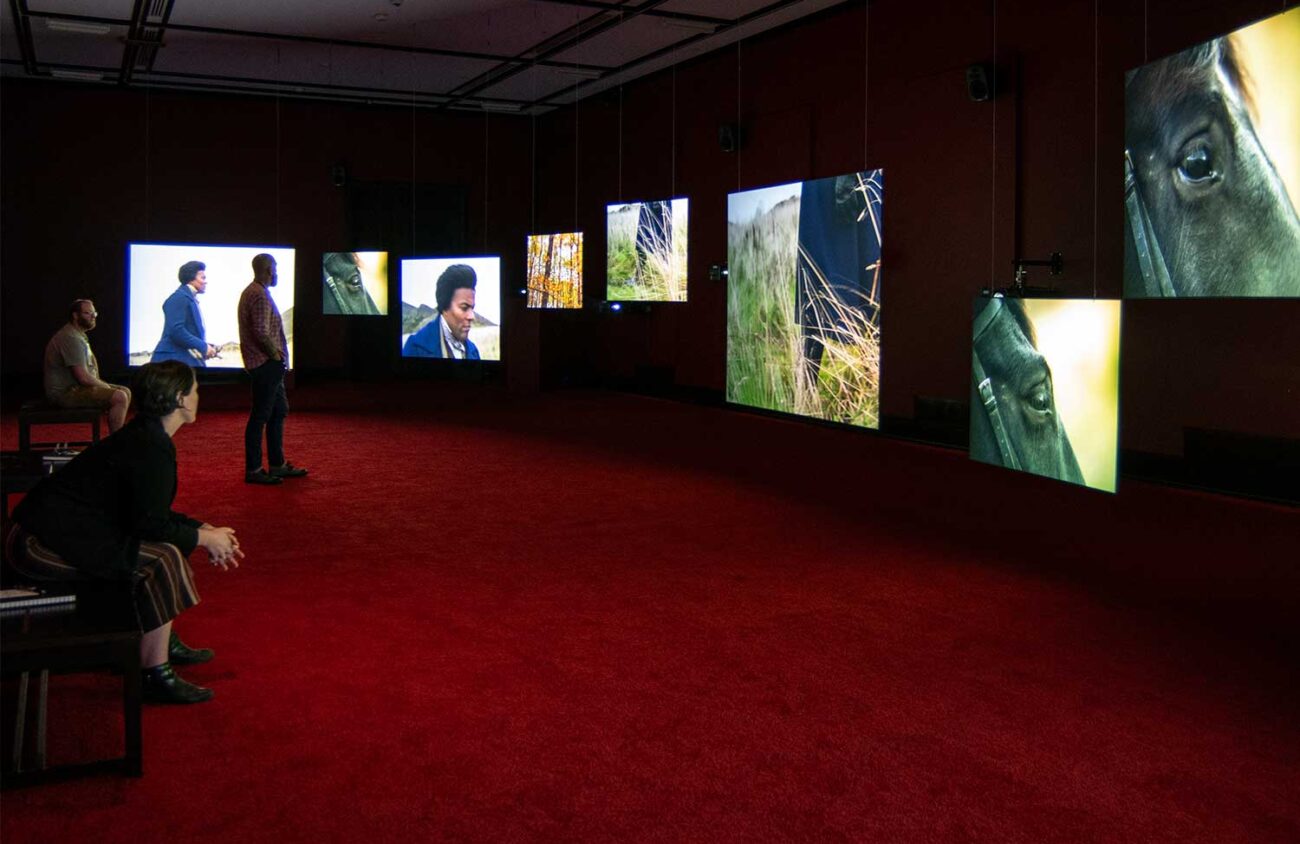Using just 10 floating screens of various sizes, internationally renowned artist Sir Isaac Julien brings the enthralling tale of 19th-century abolitionist Frederick Douglass to life at the Jordan Schnitzer Museum of Art.
Julien first gained prominence with his 1989 release of Looking for Langston, a short film made in memory of Langston Hughes, the leader of the Harlem Renaissance in New York.
The multiscreen film installation Lessons of the Hour — Frederick Douglass was JSMA Executive Director John Weber’s dream exhibit when he interviewed for his position in 2019.
“I already deeply admired Isaac’s work, particularly the multiscreen pieces. I’d seen a number of those in different places and thought they were some of the most exciting artworks happening today, anywhere,” Weber says. “And so when I heard that he was doing Frederick Douglass, I just thought, ‘This is the dream piece.’”
When Julien and Weber ran into each other in December 2019 at an arts festival in Miami, Weber told Julien about his job at the University of Oregon and asked to exhibit Lessons of the Hour at the JSMA.
Julien readily agreed, Weber says, but then the pandemic struck. It wasn’t until summer 2022 that the two of them began to settle on dates for the exhibit.
“I hadn’t seen the piece when I knew I wanted to bring it. When you work with artists, you see their work over time and you develop confidence in them,” Weber says. “Knowing Isaac Julien’s work, I knew this would be a great piece. And it’s even better than I anticipated.”
After hearing such high praise, I had to see the film for myself.
“The sound is like the supporting cast,” Debbie Williamson, the JSMA communications manager, told me as she walked me to the darkened exhibit. She advised that I sit on one of the middle two benches to get the best experience.
According to Williamson, there is no true start or stop to the exhibit, but I definitely entered at the end. Douglass was standing at the top of a hill on one screen when all the others cut to black. I was plunged into the dark as I found my seat.
The screens came alive again — first one, then three, then five and all — to shots of Ray Fearon, the British Shakespearean actor portraying Douglass, strolling through a forest in a burgundy coat in the midst of autumn.
The film tours Douglass’ Washington D.C. house, called Cedar Hill, which has been preserved and kept to its 19th-century quality. Sounds of life come from every direction — a clock ticking, a sewing machine running — despite no one being home. The noise blends into one as the sewing machine’s methodic thrums transform into a train rolling on tracks.

Suddenly, Douglass’ reality collides with the modern world. The audience Douglass is speaking to is intermixed with those dressed as though they’re of the Gilded Age and those dressed as though they’re of the Digital Age.
Douglass recites “What to the Slave is the Fourth of July,” a speech he gave in New York in 1852, to the multigenerational crowd. On only one of the 10 screens does Douglass appear. The rest feature shots of the audience, fireworks over a city skyline, the Baltimore Freddie Gray protests and re-created slave ships.
The image and audio of Douglass jumps from screen to screen, calling your eyes to follow.
“The installation moves your attention around in space. And actually, in a sense, in time, too, because you’re looking at representations of the past and also the present,” Weber says. “I love how the piece moves our consciousness around thinking about the impact of the past on the present, and how we’re still trying to come to terms with our past in the U.S., still trying to create for everyone the equality promised in the Constitution.”
The black-and-white drone footage of the protests in Baltimore was shot just 38 miles from Douglass’ house. The fireworks fade to smoke as Douglass’ oration ends, leaving behind an almost unsettling feeling.
Then I reunited with Douglass on the rocky hill where we were first introduced, but this time I had a whole new perspective of the man.
The JSMA includes two guestbooks in the exhibit where viewers can write down their thoughts on the piece.
“Amazing. Humbling. Devastating. Educational. Beautiful. Necessary,” one entry reads. “Thank you for the exhibit. [Douglass] was a powerful man and a hell of a writer. A brilliant mind, eloquent author.”
Lessons Of The Hour — Frederick Douglass is at the Jordan Schnitzer Museum Of Art through Dec. 10. The JSMA is open from 11 am to 8 pm on Wednesdays and 11 am to 5 pm every other day of the week. Admission is $5 for adults, $3 for seniors (62+) and free for everyone else.
A Note From the Publisher

Dear Readers,
The last two years have been some of the hardest in Eugene Weekly’s 43 years. There were moments when keeping the paper alive felt uncertain. And yet, here we are — still publishing, still investigating, still showing up every week.
That’s because of you!
Not just because of financial support (though that matters enormously), but because of the emails, notes, conversations, encouragement and ideas you shared along the way. You reminded us why this paper exists and who it’s for.
Listening to readers has always been at the heart of Eugene Weekly. This year, that meant launching our popular weekly Activist Alert column, after many of you told us there was no single, reliable place to find information about rallies, meetings and ways to get involved. You asked. We responded.
We’ve also continued to deepen the coverage that sets Eugene Weekly apart, including our in-depth reporting on local real estate development through Bricks & Mortar — digging into what’s being built, who’s behind it and how those decisions shape our community.
And, of course, we’ve continued to bring you the stories and features many of you depend on: investigations and local government reporting, arts and culture coverage, sudoku and crossword puzzles, Savage Love, and our extensive community events calendar. We feature award-winning stories by University of Oregon student reporters getting real world journalism experience. All free. In print and online.
None of this happens by accident. It happens because readers step up and say: this matters.
As we head into a new year, please consider supporting Eugene Weekly if you’re able. Every dollar helps keep us digging, questioning, celebrating — and yes, occasionally annoying exactly the right people. We consider that a public service.
Thank you for standing with us!

Publisher
Eugene Weekly
P.S. If you’d like to talk about supporting EW, I’d love to hear from you!
jody@eugeneweekly.com
(541) 484-0519
